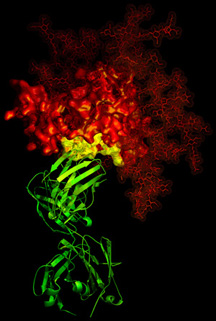

Scientists Unveil Structure that May Be Key to AIDS Vaccine Development
Anne Oplinger and Mika Ono
In a finding that could have profound implications for AIDS vaccine design, researchers have generated an atomic-level picture of a key portion of an HIV surface protein as it looks when bound to an infection-fighting antibody. Unlike much of the constantly mutating virus, this protein component is stable and, more importantly, appears vulnerable to attack from this specific antibody, known as b12, that can broadly neutralize HIV.
"The structure is an important advance in efforts to rationally design an HIV vaccine," says Dennis Burton, a professor at The Scripps Research Institute and an author of the paper.
The current research, which appears in the February 15 issue of Nature, delineates for the first time the detailed structure of a protein called gp120, a major component of HIV's outer coat, in complex with the broadly neutralizing antibody b12. The research also details the precise stepwise engagement between gp120 and CD4, a glycoprotein on the surface of certain cells that acts as a receptor for HIV. This encounter starts with a highly focused contact and then expands to a broader surface that stabilizes the interaction.
Importantly, the scientists found that this initial point of CD4 contact is a potential site of weakness for HIV because it is also the site of recognition—called an epitope—for neutralizing antibody b12. The structure of this gp120 epitope, and its susceptibility to attack by a broadly neutralizing antibody, shows scientists a critical area of vulnerability on the virus that they may be able to target with vaccines.
HIV causes AIDS by binding to, entering, and, ultimately, leading to the killing of blood cells with CD4 on their surfaces. T cells and macrophages, which both carry CD4, are necessary to fight off infections by common bacteria and other pathogens, and these pathogens become potentially lethal to patients after their own immune system destroys the infected CD4 cells.
One approach to designing an effective HIV vaccine is to induce antibodies against the virus. Also called immunoglobins, these antibodies would be produced by the body's B cells after HIV enters the bloodstream. During such an immune response, the antibodies would circulate through the blood, and track down and kill the virus.
Most of the antibodies that the body produces to fight HIV, however, are ineffective. The surface of the virus is cloaked with sugar molecules that prevent antibodies from slipping in and blocking the proteins the virus uses to latch onto a cell and infect it. To make matters more complicated, HIV is constantly mutating, so there are multiple HIV strains that any antibodies used in a vaccine must be able to sense and destroy.
Nonetheless, while rare, broadly neutralizing antibodies against HIV do exist. In 1994, Burton, Scripps Research Professor Carlos Barbas III, and colleagues identified broadly neutralizing antibody b12. The antibody came from the bone marrow of a 31-year-old male who had been HIV positive without symptoms for six years.
In 2001, research carried out by Erica Ollmann Saphire, then in the Scripps Research lab of Professor Ian Wilson, and now a faculty member in the Scripps Research Department of Immunology, solved the structure of b12. The team, which also included Burton and Wilson, found the antibody has a long finger-like region on its surface that penetrates the surface of gp120 on the HIV virus and prevents it from causing disease.
Efforts to crystallize b12 bound to gp120 were at first impeded by the inherently flexible nature of gp120. To overcome the problem, the investigators in the current study created a variety of gp120s and eventually made the protein stiff enough to capture a picture of it in complex with b12.
The researchers saw that b12 binds gp120 at the same point where gp120 initially attaches to CD4. Unlike the gp120-CD4 interactions, however, b12 can latch onto the site of CD4's first contact without requiring a shape change in gp120 to create a stable interaction between the two molecules.
The current study, titled "Structural definition of a conserved neutralization epitope on HIV-1 gp120," was led byPeter Kwong of the Vaccine Research Center, National Institute of Allergy and Infectious Diseases (NIAID), at the National Institutes of Health (NIH). In addition to Burton, other authors of the paper included: Tongqing Zhou, Ling Xu, Barna Dey, Richard Wyatt, and Gary J. Nabel of the Vaccine Research Center, NIAID; Donald Van Ryk of the Laboratory of Immunoregulation at NIAID; Shi-Hua Xiang, Xinzhen Yang, and Joseph Sodroski of the Dana-Farber Cancer Institute; Mei-Yun Zhang, James Arthos, and Dimiter S. Dimitrov of the National Cancer Institute, NIH; and Ann J. Hessell and Michael B. Zwick of Scripps Research.
Support for this work was provided by the Intramural Research Program of the NIH, by the International AIDS Vaccine Initiative, by a grant from the Bill and Melinda Gates Foundation Grand Challenges in Global Heath Initiative, and by grants from the NIH. Use of SER-CAT at the Advanced Photon Source was supported by the US Department of Energy, Basic Energy Sciences, Office of Science.
Send comments to: mikaono[at]scripps.edu

A potential site of weakness for HIV. Here, a 3-D x-ray crystallographic image shows the broadly neutralizing antibody b12 (green ribbon) in contact with a critical target (yellow) for vaccine developers on HIV-1 gp120 (red). Image courtesy of NIAID.
